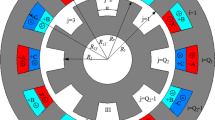Abstract
In order to improve the efficiency and flexibility of the switched reluctance generator, a novel deflection double stator switched reluctance generator was proposed based on the structural characteristics of the switched reluctance motor. The magnetic flux of the generator was analyzed by magnetic circuit analysis method, obtaining the matrix expression of the average magnetic flux of the stator and rotor. Then it is transiently simulated by electromagnetic analysis software to calculate the radial and tangential components of the core magnetic density of the generator. At the same time, the calculation results of the finite element method are compared with the results of the analysis method to verify the correctness of the analytical method model. Finally, the calculated magnetic density component is transformed by Fourier transformation to obtain the corresponding harmonic analysis. And the ellipse method was used to calculate the iron loss of the generator, compared with the experimental results to illuminate the accuracy of the iron loss calculation scheme.
















Similar content being viewed by others
References
Yu Q, Bilgin B, Emadi A (2015) Loss and efficiency analysis of switched reluctance machines using a new calculation method. IEEE Trans Ind Electron 62(5):3072–3080
Valdivia V, Todd R, Bryan F, Barrado A (2014) Behavioral modeling of a switched reluctance generator for aircraft power system. IEEE Trans Ind Electron 61(6):2690–2699
Yan W, Chen H, Chen L, Wang K (2017) Iron loss analysis on switched reluctance motor under different control modes. IET Electr Power Appl 11(9):1575–1584
Charton JT, Corda J, Stephenson JM, Randall SP (2006) Dynamic modelling of switched reluctance machines with iron losses and phase interactions. IEE Proc Electr Power Appl 153(3):327–336
Heidarian M, Ganji B (2016) A dynamic simulation model based on finite element method for switched reluctance generator. In: International symposium on power electronics, electrical drives, automation and motion (SPEEDAM). IEEE, Anacapri, Italy
Xu T, Yuan J, Wang Q, Chen H (2016) Inductance estimation method for linear switched reluctance machines considering iron losses. IET Electr Power Appl 10(3):181–188
Ding W, Liu L, Lou J, Liu Y (2013) Comparative studies on mutually coupled dual-channel switched reluctance machines with different winding connections. IEEE Trans Magn 49(11):5574–5589
Yu Q, Gerling D (2013) Analytical modeling of a canned switched reluctance machine with multilayer structure. IEEE Trans Magn 49(9):5069–5082
Chen L, Chen H, Yan W (2017) A fast iron loss calculation model for switched reluctance motors. IET Electr Power Appl 11(3):478–486
Wang Q, Wang J, Nie R, Abbas S (2016) Position estimation of linear switched reluctance machine with iron losses based on eddy-current effect. IET Electr Power Appl 10(8):772–778
Yu S, Zhang F, Ahn J-W (2013) Efficiency of switched reluctance generator according to current shape below rated speed. In: International conference on electrical machines & systems, IEEE, Busan, South Korea
Lee H-J, Park H-J, Hong H-S, Won S-H, Jin C-S, Lee B-S, Lee J (2015) An analytic analysis of the multi-degree-of-freedom actuator. IEEE Trans Magn 51(3):1–4
Li Z, Lun Q, Xing D, Gao P (2015) Analysis and implementation of a 3-DOF deflection-type PM motor. IEEE Trans Magn 51(11):1–4
Gravagne I, Walker ID, Rahn CD (2013) Large-deflection dynamics and control for planar continuum robots. IEEE/ASME Trans Mech 8(2):299–307
Li Z, Gao D, Dee J, Dee J, Ahn J-W (2012) Power closed-loop control for high efficiency switched reluctance generator. In: Vehicle power & propulsion conference. IEEE, Seoul, Korea
Liu X, Wang C, Chen Z (2015) Characteristics analysis of an excitation assistance switched reluctance wind power generator. IEEE Trans Magn 51(11):1
Choi D-W, Byun S-I, Cho Y-H (2014) A study on the maximum power control method of switched reluctance generator for wind turbine. IEEE Trans Magn 50(1):1–4
Chen H, Sun C, Wang Q (2014) Analysis of flux-linkage characteristics of switched reluctance linear generator. IEEE Trans Appl Supercond 24(3):1–5
Xue XD, Cheng KWE, Bao YJ, Leung PL (2012) Switched reluctance generators with hybrid magnetic paths for wind power generation. IEEE Trans Magn 48(11):3863–3866
Burkhart B, Klein-Hessling A, Hafeez SA, De Doncker RW (2016) Influence of freewheeling on single pulse operation of a switched reluctance generator. In: International conference on electrical machines & systems, IEEE, Chiba, Japan
Antoni A, Xavier R, Mickal H (2013) Enhancing the flux estimation based sensorless speed control for switched reluctance machines. Electr Power Syst Res 104(9):62–70
Funding
Funding was provided by National Natural Science Foundation of China (Grant nos. 51577048, 51877070, 51637001), Natural Science Foundation of Hebei Province of China (Grant no. E2018208155), Hebei Province Higher Education Science and Technology Research Key Project (Grant no. ZD2018228), High-energy-saving motor and control technology National and Local Joint Engineering Laboratory Open Project Funded Project (Grant no. KFKT201804) and Hebei Province Graduate Innovation Funding Project (Grant nos. CXZZSS2018085, CXZZSS2019084).
Author information
Authors and Affiliations
Corresponding author
Additional information
Publisher's Note
Springer Nature remains neutral with regard to jurisdictional claims in published maps and institutional affiliations.
Rights and permissions
About this article
Cite this article
Li, Z., Wang, X., Zhang, L. et al. Magnetic Field Analysis and Iron Loss Calculation of a Special Switched Reluctance Generator. J. Electr. Eng. Technol. 14, 1991–2003 (2019). https://doi.org/10.1007/s42835-019-00234-6
Received:
Revised:
Accepted:
Published:
Issue Date:
DOI: https://doi.org/10.1007/s42835-019-00234-6




